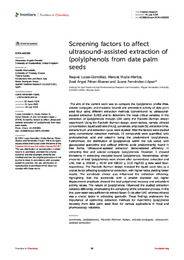Por favor, use este identificador para citar o enlazar este ítem:
https://hdl.handle.net/11000/35005Registro completo de metadatos
| Campo DC | Valor | Lengua/Idioma |
|---|---|---|
| dc.contributor.author | Lucas González, Raquel | - |
| dc.contributor.author | Viuda-Martos, Manuel | - |
| dc.contributor.author | Pérez-Alvarez, José Angel | - |
| dc.contributor.author | Fernandez-Lopez, Juana | - |
| dc.contributor.other | Departamentos de la UMH::Tecnología Agroalimentaria | es_ES |
| dc.date.accessioned | 2025-01-20T09:36:21Z | - |
| dc.date.available | 2025-01-20T09:36:21Z | - |
| dc.date.created | 2024-07-16 | - |
| dc.identifier.citation | Frontiers in Chemistry. Volume 12 (2024) | es_ES |
| dc.identifier.issn | 2296-2646 | - |
| dc.identifier.uri | https://hdl.handle.net/11000/35005 | - |
| dc.description.abstract | The aim of the current work was to compare the (poly)phenol profile (free, soluble-conjugate, and insoluble-bound) and antioxidant activity of date palm seed flour using different extraction methods (conventional vs. ultrasound-assisted extraction [UAE]) and to determine the most critical variables in the extraction of (poly)phenols through UAE using the Plackett–Burman design experiment. Using the Plackett–Burman design, seven factors, namely, ethanol concentration, liquid:solid ratio (mL/g), sonotrode, amplitude (%), extraction time, extractant pH, and extraction cycle, were studied. After the factors were studied using conventional extraction methods, 23 compounds were quantified, with protocatechuic acid and catechin being the predominant (poly)phenols. Furthermore, the distribution of (poly)phenols within the cell varied, with glycosylated quercetins and caffeoyl shikimic acids predominantly found in free forms. Ultrasound-assisted extraction demonstrated efficiency in extracting free and soluble-conjugate (poly)phenols. However, it showed limitations in extracting insoluble-bound (poly)phenols. Nevertheless, similar amounts of total (poly)phenols were shown after conventional extraction and UAE, that is, 259.69 ± 43.54 and 189.00 ± 3.08 mg/100 g date seed flour, respectively. The Plackett–Burman design revealed the liquid–solid ratio as a crucial factor affecting (poly)phenol extraction, with higher ratios yielding better results. The sonotrode choice also influenced the extraction efficiency, highlighting that the sonotrode with a smaller diameter but higher displacement amplitude showed the best polyphenol recovery and antioxidant activity values. The nature of (poly)phenols influenced the studied extraction variables differently, emphasizing the complexity of the extraction process. In this line, pure water was sufficient to extract flavan-3-ols after UAE, whereas ethanol was a crucial factor in extracting quercetin. These findings underscore the importance of optimizing extraction methods for maximizing (poly)phenol recovery from date palm seed flour for various applications in food and pharmacology industries | es_ES |
| dc.format | application/pdf | es_ES |
| dc.format.extent | 10 | es_ES |
| dc.language.iso | eng | es_ES |
| dc.publisher | Frontiers Media | es_ES |
| dc.rights | info:eu-repo/semantics/openAccess | es_ES |
| dc.rights | Attribution-NonCommercial-NoDerivatives 4.0 Internacional | * |
| dc.rights.uri | http://creativecommons.org/licenses/by-nc-nd/4.0/ | * |
| dc.subject | Sonotrode | es_ES |
| dc.subject | (Poly)phenols | es_ES |
| dc.subject | Plackett-Burman design | es_ES |
| dc.subject | Soluble-conjugate | es_ES |
| dc.subject | Ultrasound-assisted extraction | es_ES |
| dc.title | Screening factors to affect ultrasound-assisted extraction of (poly)phenols from date palm seeds | es_ES |
| dc.type | info:eu-repo/semantics/article | es_ES |
| dc.relation.publisherversion | https://doi.org/10.3389/fchem.2024.1409393 | es_ES |

Ver/Abrir:
Screening factors to affect ultrasound-assisted extraction of....pdf
895,79 kB
Adobe PDF
Compartir:
 La licencia se describe como: Atribución-NonComercial-NoDerivada 4.0 Internacional.
La licencia se describe como: Atribución-NonComercial-NoDerivada 4.0 Internacional.
.png)